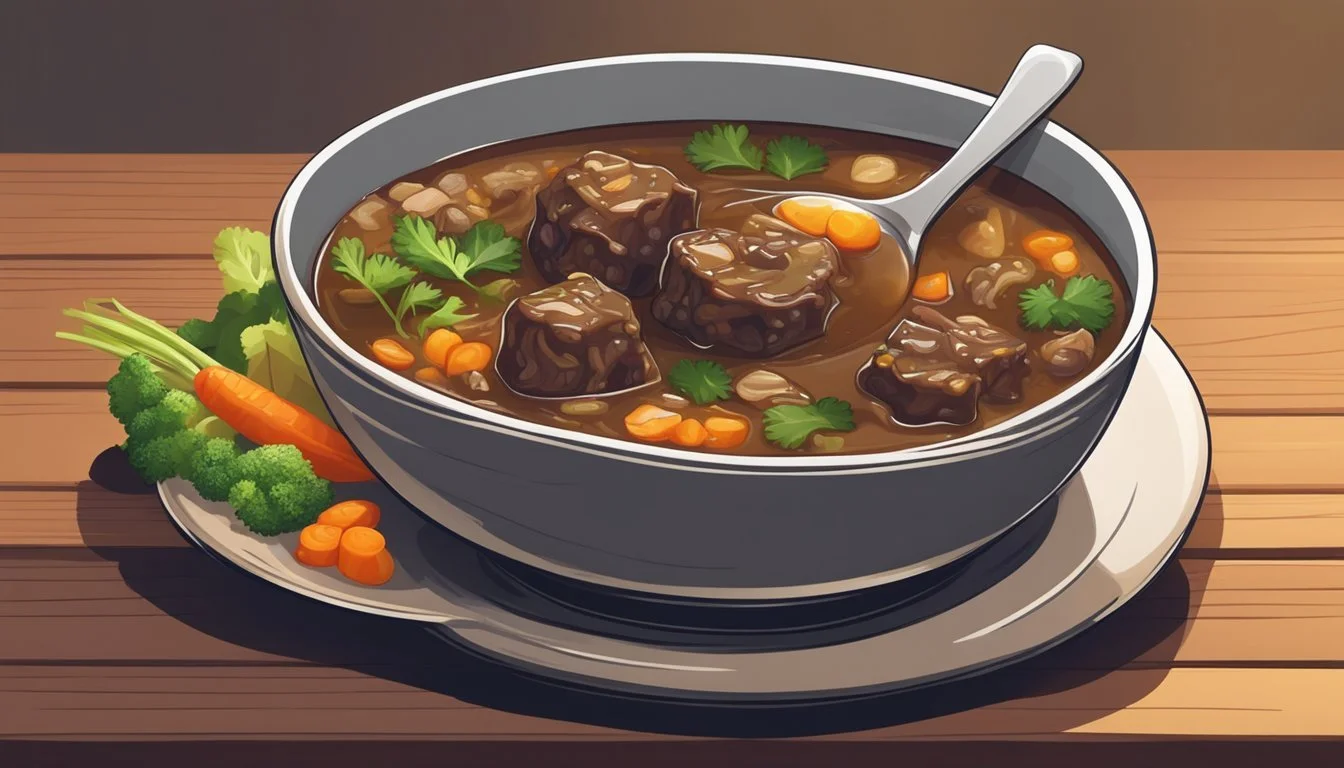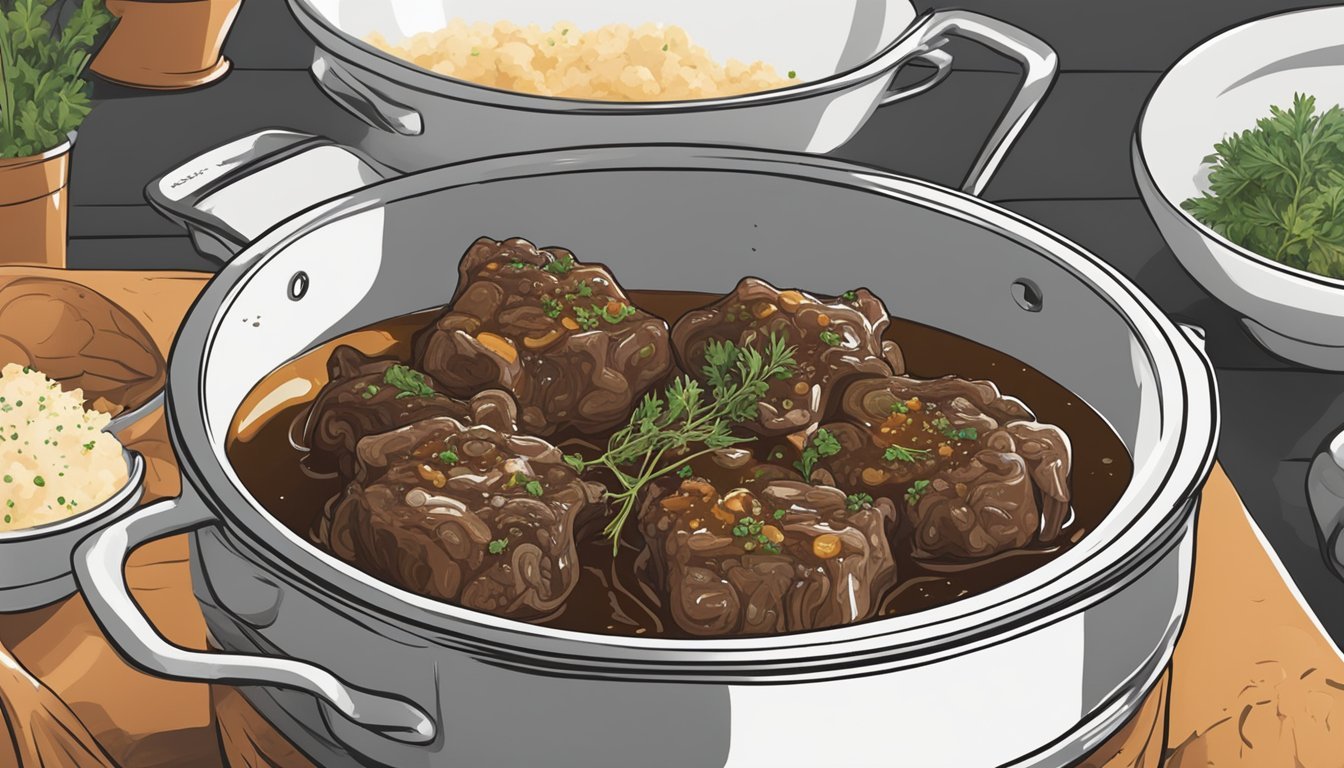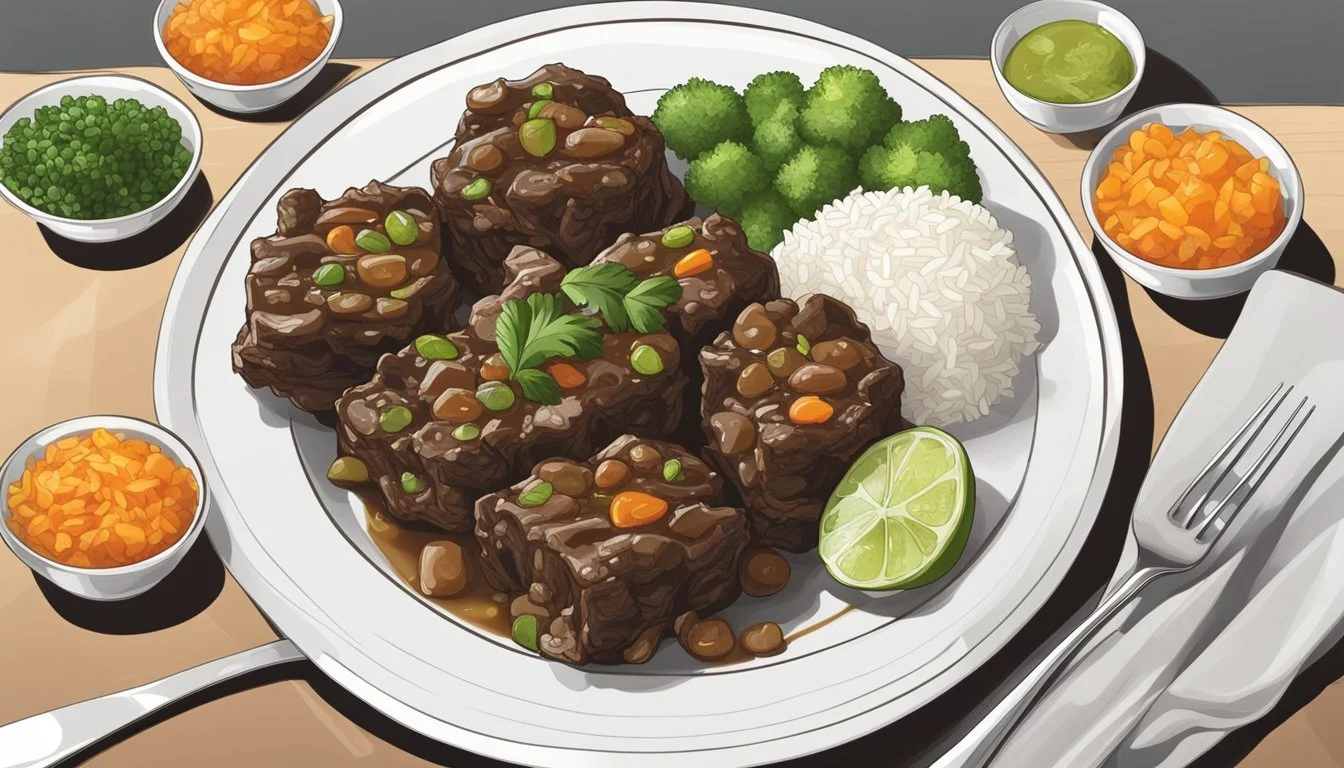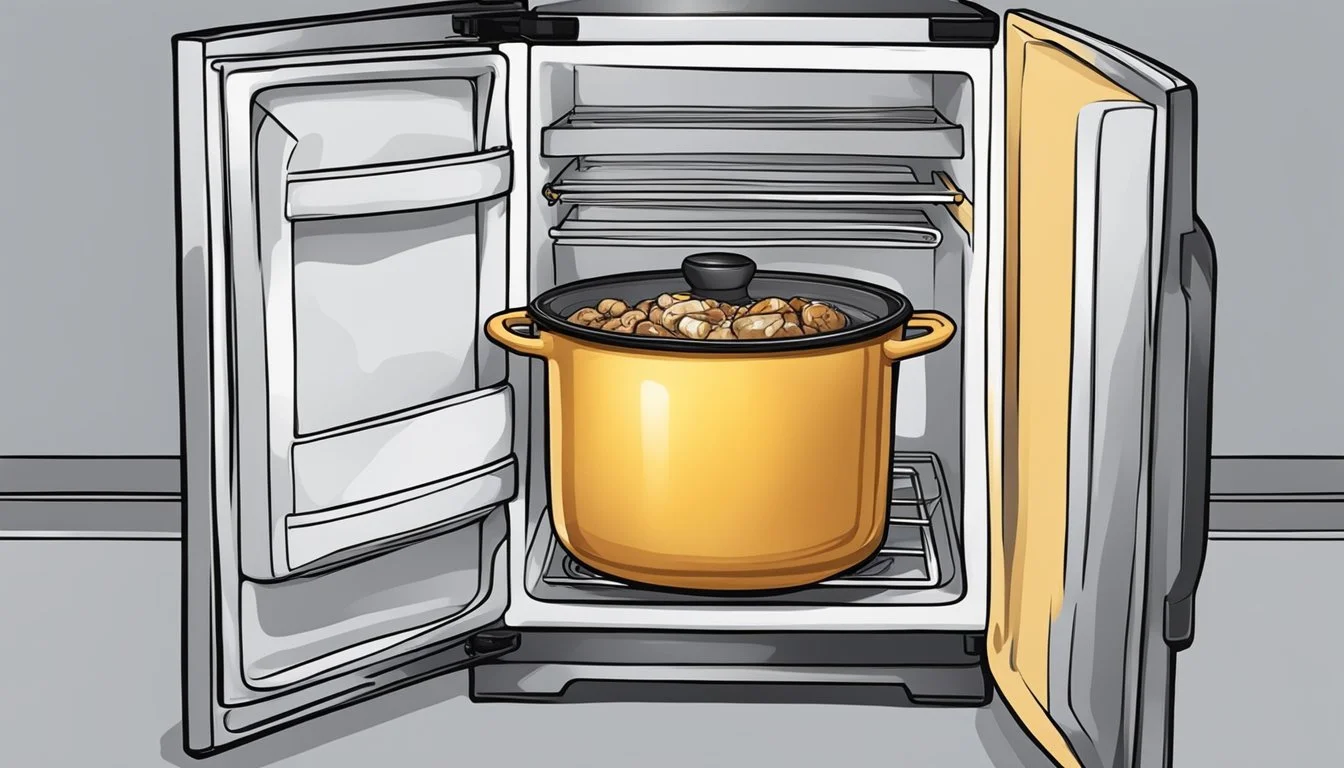How do you eat oxtail?
Understanding the Basics of Preparing and Enjoying This Delicacy
Oxtail, the culinary term for the tail of cattle, has a rich history rooted in the tradition of utilizing every part of the animal. Originally sourced from oxen, it is now obtained from both beef cattle and veal and is widely appreciated for its robust flavor and succulent, gelatinous texture. The meat, which adorns the tailbone, is highly regarded for its use in slow-cooked dishes such as stews (What wine goes well with stews?) and soups, which allow the full depth of its taste to emerge.
To consume oxtail, one must typically engage in a slow cooking process that tenderizes the meat and releases the marrow within the bones. This method ensures that the toughness, a natural characteristic of the well-exercised muscle, is transformed into a tender, flavorful experience. The preferred techniques for cooking oxtail involve braising and stewing, often with a mix of savory vegetables, to create intensely flavored, richly textured meals such as the classic oxtail stew or oxtail soup.
Given its high collagen content, oxtail imparts a velvety consistency to the dishes it enriches. When prepared in a stew or soup, the meat becomes fall-off-the-bone tender, making it an enjoyable dish that requires a simple approach to eating—usually a fork for the meat and a spoon to relish the hearty, comforting broth. The culinary adventure of eating oxtail is in both the preparation and the enjoyment of its unique taste and texture.
Understanding Oxtail
Rich in history and nutritional value, oxtail refers to the tail of beef cattle, which is revered for its gelatinous texture when cooked due to a high collagen content. This culinary delicacy offers a window into traditional cooking practices and nutritional benefits.
Historical Significance
Oxtail has been a part of the human diet since the consumption of beef began, originating from a time when no part of an animal was wasted. Traditionally, the tail was used to create hearty soups that extended the value of meat through the addition of vegetables and grains. Oxtail once came from oxen but today is synonymous with the tail of any beef cattle.
Nutritional Profile
As a cut of meat, oxtail is protein-rich and contains essential vitamins and minerals, contributing to its nutritional density. The meat's high gelatin content, derived from collagen within the cartilage and bone, is a source of amino acids that are beneficial for joint health. The marrow within the tailbones further enriches the meat's flavor and nutritional value.
Nutrient content (per 100g of oxtail):
Protein: Approximately 30g
Calories: Around 250-300 kcal
Fat: 15g, predominantly from the bone marrow
Vitamins and Minerals: Includes vitamin B12, phosphorus, iron, and zinc
Anatomical Features
Oxtail is the culinary name for the tail of a cow and comprises a series of small bones that are interspersed with muscle and interspersed with thick layers of collagen and cartilage. The tail is a gelatinous cut due to the high concentration of connective tissues.
Butchery and Purchasing
Oxtail can be obtained from butchers and is sometimes available at grocery stores. A butcher typically slices the tailbone into sections across the bone, each containing a portion of meat and marrow. When purchasing oxtail, one should look for pieces with a robust red color, indicating freshness, and a moderate amount of fat for flavor.
Considerations when purchasing:
Appearance: Look for a vibrant red color and marbling.
Quantity: Oxtail is sold by weight; ensure you purchase enough for your recipe, as it contains bone.
Preparation: Butchers may offer it whole or pre-cut into sections.
Preparation Techniques
When preparing oxtails, one must focus on cleaning, marinating, and browning to maximize the meat's rich flavor and tenderness. These preliminary steps are crucial in enhancing both the taste and the texture of oxtails.
Cleaning and Cutting
Before cooking, oxtails should be thoroughly rinsed to remove any bone fragments and debris. Soaking them in water can help in this process. Once clean, the oxtails should be patted dry and cut into sections at the joints. Each piece should include a segment of bone and meat, ensuring the marrow remains within, contributing to the stock’s flavor during cooking.
Marinating the Meat
Marinating the oxtail can infuse it with robust flavors and begin the tenderization process. A simple marinade might include olive oil, vinegar, and a blend of herbs and spices suited to one's taste. Cover the oxtail pieces in the marinade and refrigerate. For optimal flavor absorption, they should marinate for several hours or, preferably, overnight.
Browning the Oxtail
Browning the oxtail is imperative for developing a deep flavor profile. To achieve this, heat a tablespoon of olive oil in a skillet over medium heat and sear the meat until it's browned on all sides. For a thicker sauce or stew, some may choose to coat the oxtail lightly with flour before browning, which can enrich the final stock with a subtle, thickened texture.
Cooking Methods
Oxtail, known for its rich flavor and succulent texture, benefits from slow, low-temperature cooking methods that allow the tough connective tissue to break down. Three common approaches include slow cooking, pressure cooking, and braising, all of which render the oxtail fork-tender and enhance the deep flavors characteristic of stews and gravies made from this cut of beef.
Slow Cooking Oxtail
Slow cooking oxtail typically involves simmering the tails in a crockpot or a slow cooker over several hours. Begin by sautéing the oxtail pieces to develop a caramelized exterior, then transfer them to the slow cooker. A mixture of broth, herbs, and vegetables can be added to create a flavorful environment for the oxtail to cook. A slow cooker set on a low temperature for about 6 to 8 hours allows the meat to become tender and the flavors to meld into a hearty stew.
Pressure Cooking Oxtail
For a faster method, pressure cookers dramatically reduce the cooking time while still providing a tender result. After browning the oxtail using the sauté function, add liquids such as wine, broth, or tomato sauce along with preferred seasonings. Secure the lid of the pressure cooker and set it to cook on high pressure for 45-60 minutes. Once cooking is complete, allowing the pressure to release naturally ensures the oxtail remains moist and tender.
Braising Oxtail
Braising combines searing with slow, wet cooking in a closely covered pot, like a Dutch oven, in the oven or on the stove. To create a foundation of flavor, one should first sear the oxtail at high temperatures until well-browned. Then, in a mixture of stock, wine, or water with aromatic vegetables and seasonings, the oxtail should braise in a low-temperature oven or at a low boil on the stovetop. This slow process, ideally lasting 2-3 hours, allows the meat to become fork-tender and the sauce to condense into a rich gravy.
Flavoring and Ingredients
The rich flavor of an oxtail stew hinges upon a blend of robust seasonings, aromatic vegetables, and the profound taste imparted by broth or wine. Precision in the selection and combination of these components is key to achieving the quintessential taste profile that oxtail is renowned for.
Spices and Seasonings
The foundation of oxtail flavor begins with its spices and seasonings. Traditional recipes call for a generous seasoning of salt and black pepper, but to truly enhance the savoriness of the beef, additional herbs such as thyme are often incorporated. The long cooking process allows the flavors to permeate the meat, ensuring that every bite is infused with the essence of the chosen seasonings.
Vegetables and Broth
Vegetables are more than just a side; they contribute significant flavor and substance to oxtail dishes. Commonly used are onions, carrots, and potatoes, which not only add depth to the stew's flavor but also provide a desirable textural contrast. The vegetables simmer in a rich beef broth or beef stock, which not only tenderizes the oxtail but also fortifies the stew with a hearty, meaty essence.
Wine and Aromatics
Inclusion of red wine in an oxtail recipe introduces a sophisticated layer of flavor, offering a slight acidity that balances the rich, savory notes of the dish. Garlic complements the wine by adding a subtle pungency, while the natural gelatin from the oxtail's bone marrow intermingles with these liquids, creating a sauce that is luxuriously silky and flavorful. Aromatic elements such as a bay leaf or a dash of Worcestershire sauce may be used to provide an additional complexity that distinguishes an oxtail dish.
Serving and Presentation
When serving oxtail, presentation plays a significant role in enhancing the dining experience. The rich flavors of the dish are complemented by thoughtful accompaniments and a visually appealing plating technique.
Accompaniments
Oxtail pairs well with a variety of side dishes that can help to balance its hearty and savory flavor. For instance:
Rice: A bed of fluffy rice is a classic foundation, especially suited for absorbing the flavorful sauces of Jamaican oxtail stew.
Butter Beans: Often included in soul food recipes, butter beans offer a creamy texture and nutty taste, complementing the tender meat.
Vegetables: For a well-rounded meal, vegetables such as squash, broccoli, cauliflower, and brussels sprouts provide a nutritious addition.
Here is a simple table outlining some typical oxtail accompaniments:
Accompaniment Description Dish Example Rice Light and fluffy, absorbs flavors well Jamaican Oxtail with Rice Butter Beans Creamy and nutty, adds textural contrast Oxtail Stew with Butter Beans Seasonal Vegetables Provides color and balances the meal's richness Oxtail with Roasted Vegetables
Plating Technique
The presentation of oxtail should highlight the tenderness of the meat and the richness of the sauce. A clean, white dish can serve as the canvas to make the colors of the oxtail and its accompaniments stand out.
Layering: Start with the base, such as rice, and then carefully place the oxtail on top, allowing the sauce to drizzle down.
Garnishing: A sprinkle of fresh herbs can add a pop of color and a burst of freshness to the dish.
Each element on the plate should be placed with intention, ensuring an appetizing appearance that anticipates the depth of flavor in the oxtail dish.
Storing and Reheating
Proper storage is crucial for maintaining the quality of oxtail dishes, while correct reheating ensures the food's safety and palatability. Here's how to manage oxtail leftovers effectively.
Refrigeration and Freezing
When storing cooked oxtail in the refrigerator, it should be cooled to room temperature within two hours of cooking to prevent bacterial growth. It is advisable to store the oxtail in airtight containers, and it can be kept for 3-4 days.
For longer storage, freezing is an option. Before placing cooked oxtail in the freezer, it is important to seal it properly in freezer-safe bags or containers. Label the storage with the date, as frozen cooked oxtail retains its best quality for 1-3 months at 0°F (-18°C).
Reheating Leftovers
When the time comes to reheat oxtail leftovers, one must ensure they are heated thoroughly to a safe temperature. If the oxtail has been frozen, one should ideally allow it to thaw in the refrigerator before reheating.
Preheat the oven to 200 degrees Fahrenheit.
If the oxtail is in a freezer-safe package, remove and place it in an oven-safe dish.
Cover with foil to retain moisture, and reheat for 40-60 minutes or until it reaches the desired temperature.
Stovetop Reheating:
Place the oxtail in a pot on medium heat.
Add a small amount of broth or water to prevent drying out.
Stir occasionally until it is evenly heated through.
Cultural Significance
Oxtail dishes reflect a deep-rooted cultural heritage across various cuisines, embracing the sustainable nose-to-tail eating philosophy that values using all parts of the animal.
Global Variations
Across the world, oxtail is a staple ingredient revered in many cultures for its rich flavor and gelatinous texture when slow-cooked. In Caribbean cuisine, particularly Jamaican oxtail stew, it is a cherished dish often served with beans, rice, and vegetables, embodying the warmth and spice of the islands. Chefs who specialize in soul food, another cuisine with African diaspora roots, typically simmer oxtail until tender, crafting stews and broths imbued with deeply satisfying flavors. The dish signifies resilience and resourcefulness, transforming a historically less-desirable cut into a premium, sought-after commodity on global menus.
Nose-to-Tail Philosophy
Nose-to-tail eating is a principle that promotes using every part of the animal in cooking, a practice that is both ethical and economical. Chefs around the world have been championing this sustainable approach, elevating oxtail from a lesser-known cut to a gourmet experience. This way of cooking aligns with traditional practices seen in cuisines that honor the entire animal, reducing waste and appreciating the unique qualities of each cut. Through nose-to-tail eating, oxtail has found its way into high-end culinary establishments, where chefs craft dishes that pay homage to this philosophy while delivering an exceptional taste.
Shopping Tips
When shopping for oxtail, consumers should focus on the quality of the meat and compare prices to ensure they are getting the best value for their money.
Selecting Quality Oxtail
They should look for oxtail that appears fresh and has a bright color. The oxtail should possess a good balance of meat to bone, with clear, visible marbling indicating that the meat will become tender and gelatinous when cooked. It's important to check that the oxtail has a small layer of fat, which contributes to the rich flavor desired in braises and stocks. Oxtail should be firm to the touch, not slimy or overly sticky. For those who prefer a more convenient option, high-quality frozen oxtail is also available and should look free of freezer burn.
Evaluating Prices
Oxtail can be a more expensive cut of beef due to its rich flavor and the tender, gelatinous texture it provides when cooked slowly. Therefore, when evaluating prices, shoppers should consider:
Retailer: Prices can vary greatly between different stores and butchers. Specialty or high-end butchers may charge more, but the oxtail may be of superior quality.
Cut: Prices might be higher for pre-cut pieces, while whole tails may offer better value and allow for more flexible portioning at home.
Fresh vs. Frozen: Fresh oxtail often commands a higher price than frozen; however, some frozen options are competitively priced without sacrificing quality.
Bulk Buying: Sometimes, buying in bulk can save money. If a shopper has adequate freezer storage, this may be an economical choice.
By carefully selecting their oxtail and evaluating the prices, consumers can ensure they purchase a product that is suitable for enriching foods like stocks and braises, while also staying within their budget.
Health Considerations
When consuming oxtail, individuals should be aware of its high fat content, including both saturated and unsaturated fats, and consider the impact on their dietary needs. Additionally, oxtail contains purines, which can impact those with gout.
Managing Fat Intake
Oxtail, like many cuts of red meat, contains a significant amount of fat. This fatty meat, with its rich marbling and connective tissues, is known for its flavor and tender texture after slow cooking. However, these same features mean it is high in saturated fats, which can contribute to high cholesterol levels if consumed in excess. Here's a quick breakdown of oxtail's fat content:
Saturated Fat: May increase cholesterol levels, which is a concern for heart health.
Unsaturated Fat: Healthier fats that are beneficial in moderation.
Connective Tissue: High in collagen, which can have nutritional benefits, but also contributes to the overall fat content.
For a healthier preparation, one might consider methods to reduce the fat content, such as trimming visible fats and skimming off fat after cooking.
Understanding Gout Risks
Purines are found in high concentrations within oxtail, especially in the connective tissues and bone marrow. When the body breaks down purines, uric acid is formed. Excessive uric acid can lead to gout, a form of arthritis characterized by painful joint inflammation. Here's what individuals with gout or high uric acid levels should keep in mind:
High-Purine Content: Oxtail's rich source of purines can exacerbate gout symptoms.
Moderation: It's recommended for those at risk to consume high-purine foods like oxtail sparingly.
Hydration: Drinking plenty of water can help to flush out excess uric acid from the body.
Patients with gout or predisposed to it should consult with a healthcare provider before incorporating oxtail into their diet.
Oxtail Recipes
Oxtail, the culinary name for the tail of a cow, provides a rich flavor and tender meat that is ideal for slow-cooking methods. These recipes highlight the versatility and depth of flavor that oxtail can bring to a dish.
Classic Oxtail Stew
Ingredients:
Oxtail, cut into segments
Beef broth
Carrots, chopped
Onions, chopped
Celery, chopped
Garlic, minced
Red wine (optional)
Flour (for thickening)
Salt and pepper to taste
Thyme
To prepare a Classic Oxtail Stew, one begins by seasoning the oxtail with salt and pepper before browning in a pan to enhance its flavor. The meat is then slow-cooked with vegetables such as onions, carrots, and celery, bathed in rich beef broth, and often a splash of red wine. Herbs like bay leaves and thyme are added for aroma. Flour may be used to thicken the broth, ensuring a hearty and flavorful stew.
Innovative Fusion Dishes
Customized Ingredients:
Oxtail
Ingredients reflecting various cuisines (e.g., soy sauce for an Asian twist)
For Innovative Fusion Dishes, chefs utilize oxtail in creative ways that infuse flavors from different culinary traditions. An example is braising oxtail in a mixture that includes soy sauce, incorporating Asian influences into the dish. Fusion dishes expand the border of traditional oxtail recipes by experimenting with diverse ingredients from across the globe, resulting in rich, innovative meals that excite the palate.
Special Cooking Equipment
When preparing oxtail dishes, having the right cooking equipment is essential to achieve the best results. Proper utensils are critical not only for cooking but also for handling the meat effectively.
Utilizing Special Pots
Pressure Cookers: A pressure cooker is an excellent option for cooking oxtail, reducing the cooking time significantly while still producing tender meat. Oxtails can be tough, so the high-pressure environment breaks down the connective tissues efficiently.
Slow Cookers and Crockpots: These are ideal for braising oxtail at a low temperature for several hours. The slow cooking process allows the flavors to develop deeply, and the meat becomes fall-off-the-bone tender. A classic example is setting the crockpot to pressure cook for around 50 minutes, then letting it release the pressure naturally.
Dutch Ovens: For oven cooking, a dutch oven provides consistent heat and is perfect for braising oxtail in the oven. The tight-fitting lid of a dutch oven seals in moisture, ensuring that the meat does not dry out during the lengthy cooking process.
Tools for Handling
Tongs: Tongs are essential for safely and effectively handling oxtail, especially when browning the meat. Due to oxtail pieces being irregularly shaped with bones, tongs provide a secure grip to turn and maneuver them in a hot pan or out of a pot.
Cooking Equipment Purpose Pressure Cookers Speed up cooking, tenderize meat Slow Cookers Slow cooking for flavor and tenderness Dutch Ovens Consistent oven heat for braising Tongs Safely handle and maneuver meat pieces
Special pots such as pressure cookers and slow cookers cater to the requirements of cooking tougher cuts, such as oxtail, beef neck, shank, and soup bones, ensuring that these cuts reach their full potential in terms of flavor and texture.
Techniques for Tender Oxtail
When preparing oxtail, achieving tenderness is critical, as the meat contains abundant collagen, which requires proper cooking to break down. Proper techniques ensure that the tough connective tissues become succulent and enjoyable.
Understanding Collagen Breakdown
The oxtail is rich in collagen, a protein found in connective tissues which helps bind muscle fibers together. This protein needs to be transformed into gelatin through slow cooking to yield tender meat. When collagen breaks down, it imparts a nutty flavor and silky texture characteristic of well-prepared stew.
Slow cooking is essential, as it allows heat to penetrate the dense tissue without drying out the meat. Methods such as stewing in liquid or braising in the oven are ideal. The oxtail should be cooked at a low temperature for an extended period—often 3 hours or more—until the collagen has adequately broken down.
One should season the oxtail liberally with kosher salt and other spices before cooking to enhance flavor. It's important to keep the meat covered with liquid during cooking; adding enough water or broth prevents the meat from drying out. This can be done in a large stockpot or a slow cooker.
Cooking with the bone-in not only contributes flavor but also aids the breakdown of collagen, as bones are a natural source of gelatin. After cooking, the meat should be so tender that it easily separates from the bone, indicating that the connective tissues have been properly transformed.








